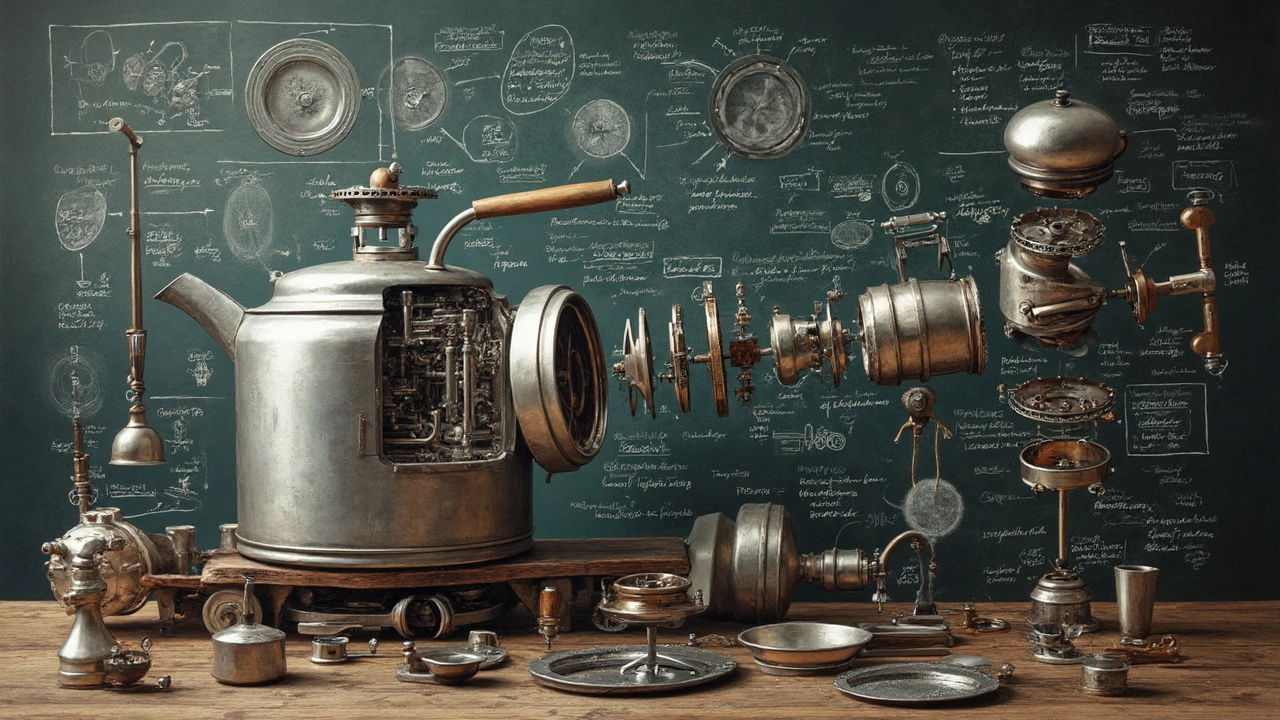Ever wonder if your trusty old pressure cooker can be fixed? Well, you're in luck! Many issues that crop up with these kitchen staples are not as daunting as they seem. Before you toss it out and spend a chunk on a new one, let's see if repair is an option.
Common issues with pressure cookers often boil down to things like faulty gaskets or pressure valves. These might sound technical, but they're usually pretty manageable with some basic tools and a bit of patience. You don't have to be a seasoned DIY expert to handle these.
One of the top problems folks encounter is a worn-out gasket, which can cause steam to escape. Replacing it is a breeze once you get the hang of it. And let's not forget about the pressure valve – a crucial part that sometimes just needs a little cleaning or adjustment.
- Common Pressure Cooker Issues
- Tools Needed for Repair
- Simple DIY Fixes
- When to Seek Professional Help
- Maintenance Tips for Longevity
Common Pressure Cooker Issues
Pressure cookers are lifesavers in the kitchen, but like all appliances, they can run into some hiccups. Let's break down the most common problems you might face and what they mean for your beloved kitchen gadget.
1. Leaking Steam
One of the main issues is the cooker leaking steam during operation. This usually indicates a problem with the gasket. If the gasket is old or worn out, it won't seal properly, causing steam to escape. Replacing the gasket is often a quick fix and can make a world of difference.
2. Difficulty in Building Pressure
If your cooker isn’t building pressure, first check the pressure valve. It might just need a good clean. Mineral deposits from water can clog this valve. A good rinse might be all it takes to get things running smoothly again. In some cases, replacing the valve could be necessary.
3. Lid Won’t Close Properly
A pressure cooker lid that refuses to close can be scary. Often, it's due to misalignment or food debris blocking the seal. Ensure the lid and pot rim are clean, and that you align the lid properly before each use.
4. Unusual Noise or Odors
Strange noises or odors often stem from food stuck in the valve, causing pressure fluctuations. Regularly inspect and clean the inside of your cooker, especially after cooking rich or sticky foods. Keeping everything squeaky clean can prevent these odd problems.
5. Pressure Indicator Not Rising
If the pressure indicator doesn’t pop up, this might be a sign of low liquid levels or again, an issue with the valve. Make sure there's enough liquid in the pot, and that the valve provides clear airflow.
- Check gasket alignment and condition regularly.
- Ensure sufficient liquids are always in the pot.
- Keep the pressure release valve clean.
- Align the lid carefully before starting.
- Follow the manufacturer's maintenance instructions.
These insights should help troubleshoot some basic pressure cooker predicaments. Often, a little know-how and regular maintenance can save you from unnecessary headaches and extend the life of your cooker.
Tools Needed for Repair
Diving into the world of pressure cooker repair? Great! Here's what you'll need to get started. Fortunately, most repairs require only basic tools, so no need to break the bank on fancy gear.
Basic Tool Kit
Your standard tool kit should cover the essentials. Here’s a quick list:
- Screwdriver Set: Flathead and Phillips should suffice for most manuals screws on the cooker.
- Pliers: Handy for gripping and twisting things like stubborn pressure valves.
- Wrench: Adjustable ones are best for any nuts and bolts that may need tightening or loosening.
Specific Pressure Cooker Tools
Aside from the basic toolkit, some specific tools can make the job easier:
- Replacement Gaskets: These are essential for sealing the lid correctly. Always check the model for the right fit.
- Pressure Valve Cleaner: Over time, debris can jam up the valve. A gentle cleaner helps keep it clear.
- Digital Multimeter: For electric pressure cookers, this helps test electrical components to ensure they’re working properly.
If you're tackling electric models, keep safety in mind. Always unplug before poking around. Gathering the right tools not only makes the process smoother but also keeps you from causing extra damage.
| Tool Type | Purpose |
|---|---|
| Screwdriver Set | Remove and secure screws |
| Pliers | Grip and hold components |
| Wrench | Tighten and loosen nuts |
| Multimeter | Check electrical parts |

Simple DIY Fixes
Tackling those pesky pressure cooker problems yourself can be a breeze with the right approach. Here, we delve into some pressure cooker repair tricks you can handle on your own without breaking a sweat.
Replacing a Worn Gasket
One of the most common issues is a worn gasket. A quick swap can make a world of difference:
- First, ensure your cooker is cool and not pressurized.
- Remove the old gasket from the lid. It may be snug, so take your time.
- Clean the gasket groove to remove any grime or residue.
- Place the new gasket in the groove, ensuring it sits evenly all around.
Voila! Your cooker should now seal properly and build pressure as it did when it was brand new.
Checking and Cleaning the Pressure Valve
A clogged pressure valve is another frequent issue that can be resolved with these simple steps:
- Once again, ensure the cooker is completely cool and depressurized.
- Remove the valve as per your cooker's manual.
- Clean any food particles or residue from the valve using a small brush or toothpick.
- Reassemble the valve, ensuring it's seated correctly.
If cleaned properly, your pressure cooker should be back to building pressure efficiently.
Repairing a Dented Base
Sometimes the base of the pressure cooker might get a little banged up, causing uneven cooking. Here's how to fix that:
- Flip the cooker over and use a rubber mallet to gently tap out any dents from the inside.
- Avoid using excessive force; gentle taps should suffice.
It's amazing what a little elbow grease and patience can do to save your trusty kitchen companion!
So, no need to stress over these easy-to-handle fixes. With these DIY repair tips, your cooker will be running like a champ in no time.
When to Seek Professional Help
Sometimes, trying to fix your pressure cooker on your own just isn't enough, and it's time to call in a professional. Here are some scenarios where you might want to consider leaving it to the experts.
Electrical Issues
If your pressure cooker isn't turning on or it's tripping the circuit breaker, it might have an electrical fault. In these cases, especially with electric models, it's safer to let a professional diagnose and fix the problem. Messing with the electrical components can be dangerous without the right knowledge.
Severe Damage
Cracked lids or warped bodies are beyond a simple DIY repair. Such significant damage compromises the cooker's ability to maintain pressure, making it unsafe to use. A professional can assess whether repairs are possible or advise if it's time for a replacement.
Persistent Pressure Problems
If you’ve tried cleaning and replacing the pressure valve multiple times with no success, there might be an underlying issue that needs professional attention. Consistent problems with pressure maintenance often indicate a deeper mechanical problem.
Leaking That Won’t Stop
When you've swapped gaskets and checked for blockages, but there's still a persistent leak, consulting a technician may be the best move. A pro can pinpoint the source, which might be hidden or more complicated than it appears.
Fixing a kitchen appliance like a pressure cooker can save you time and money, but knowing when to seek help is essential to avoid further damage or safety hazards. If you're ever in doubt, reaching out to an expert ensures your trusty cooker can cook on for years to come.

Maintenance Tips for Longevity
Keeping your pressure cooker in tip-top shape isn't as tricky as you might think. With a bit of regular care, you can extend its life and ensure it works smoothly whenever you need it.
Regular Cleaning
First things first, cleanliness goes a long way. Always clean your pressure cooker after each use. Rinse all the individual parts and make sure there's no food residue stuck in crevices, which can mess with the pressure mechanism.
Focus on Sealing Ring
The sealing ring, or gasket, is super important. Make sure it's free from any oils and food particles. If it gets stretched or damaged, it’s time to replace it. Most manufacturers recommend replacing the gasket every 12-18 months, depending on how often you use your cooker.
Inspect the Pressure Valve
A blocked pressure valve can spell disaster. Regularly check that it's clear and functioning properly. Any blockages should be carefully cleaned out to prevent pressure build-up.
Check for Wear and Tear
It's a good idea to periodically examine your kitchen appliance for any signs of wear and tear. Look for cracks or deformities in parts that might require replacing.
Store It Properly
When storing your pressure cooker, keep the lid upside down on the pot. This prevents any smell build-up and ensures that the gasket isn't constantly compressed, which can shorten its life.
Final Thoughts
A little bit of regular maintenance goes a long way in preserving the efficiency and longevity of your pressure cooker. By following these simple tips, you’re not only saving money but also getting more meals cooked to perfection.
